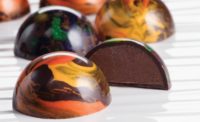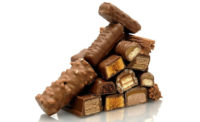There’s nothing like a FDA regulatory proposal to turn one’s world upside down. And while the agency’s November 2013 proposal to revoke the GRAS (Generally Recognized As Safe) status of partially hydrogenated oils (PHOs) caused a flurry amongst many food manufacturers, it wasn’t necessarily targeted toward confections.
As Jeffrey Fine, v.p. of customer innovation for AAK points out, “Confectionery coating fats are generally close to fully saturated and while often times are hydrogenated, they are generally not ‘partially’ hydrogenated. Nevertheless, given the uncertainty of the FDA’s final ruling, an increasing number of customers are seeking only non-hydrogenated options for coating fats. This is a trend that will presumably continue for the near future.”
Courtney LeDrew, marketing manager for Cargill Cocoa & Chocolate, concurs. And although the FDA hasn’t yet defined PHOs, many companies are already searching for PHO alternatives.
“Consumers are becoming increasingly interested in overall well-being and they’re starting to avoid certain types of fats, including saturated fats and partially hydrogenated oil,” she says. “Leading oil companies are working in this area to formulate solutions.”
So how does this affect compound coatings? Well, for one, it’s placing a great deal of pressure on oil suppliers to come up with healthier alternatives for the compound coatings already in use. Similar to the Herculean efforts to remove trans fats, compound coating and oil suppliers are focused on delivering what their customers and consumers want.
The push now, besides removing PHOs, is lowering saturated fat levels. Easier said than done, but progress is being made, says Dan Kazmierczak, Blommer’s R&D manager, specialty coatings.
“The problem in the past is that higher saturated oils were needed from a texture and shelf stability standpoint,” he says. “We have, however, seen some movement from a couple of suppliers to provide lower saturated fat alternatives, but still maintain hardness at room temperature. Customers are very interested in them, but there are textural and flavor differences.”
As Laura Bergen, senior marketing manager for Barry Callebaut explains, “Saturated fats play a critical role to the functionality of the coating, so depending on the application, saturated fats are important to some compound coatings. Less saturated fats in compound coatings typically cause handling and production issues.”
Fine heartily concurs.
“The health effects of saturated fat continue to be of a concern to food manufacturers and consumers alike,” he says. “Reducing the saturated fat in compound coatings is particularly challenging since it is a solid (saturated) fat that contributes the structure, rigidity and integrity of a confectionery coating. Lauric-based compound coatings are trans-free, but generally contain around 95 percent saturated fat. Recent R&D efforts to reduce the saturated fat in confectionery coatings are beginning to pay off.”
He cites AAK-USA’s Cebes LS60 and Cebes LS 70 products, which contain 60 percent and 70 percent saturated fat, respectively, as examples.
“This represents a dramatic reduction in saturated fat compared to conventional cocoa butter substitutes,” he adds.
But it’s not just about reducing or eliminating fats. Manufacturers are turning to compound coatings to introduce beneficial additives, such as protein or fiber.
“Functional coatings are a great way to incorporate some healthy ingredients while not giving away flavor,” Kazmierczak says. “Cocoa and other flavors do a great job of masking off-notes. Over the last few years we’ve seen the addition of protein become a huge trend. Whey or milk protein is by far the largest, but we’re also seeing a lot of different types of protein being used such as pea, soy and canola.
“Fiber of different variants is also very popular and it’s interesting as each organization has its own source of fiber that they are using,” he adds. “Other nutrients we’ve worked with in the lab over the last few years include flax, calcium and probiotics. We don’t feel that trend is going away and know that people are looking to add the next hot healthy ingredient to a coating.”
According to a 2012 Innova Market Insights report, functional foods with inherent benefits have been growing, and this trend is expected to continue, LeDrew points out. Moreover, with compound coatings, manufacturers are not limited in the flavors, colors and added nutrients that can be used when developing coatings and fillings, allowing a great deal of flexibility and creativity.
“Nutritive claims are important because consumers want to be able to indulge while doing something good for their health,” she says. “Protein is gaining interest and evidence indicates that protein is a long-term trend, and not just a fad. Protein is not just about trying to build muscle, it’s also about weight control, satiety, healthier snacking and sport nutrition.”
Moreover, protein products have now become applicable to a wider audience, LeDrew says, appealing to aging Baby Boomers, individuals trying to maintain or lose weight, athletes as well as anyone seeking products that keep them fuller longer.
“Chocolate and protein pair well together, and under the Wilbur brand, we offer innovative protein coatings and drops including Wilbur Y854 confectionery protein wafers, Wilbur Y855 milk confectionery protein wafers, Wilbur Y938 white chocolate protein drops, and Wilbur Y985 cocoa confectionery protein drops.”
Bergen agrees, noting that consumers are constantly looking for that blend of decadent yet healthy items.
“Fiber has been one healthy alternative in compound coatings and very popular with consumers,” she says. “Even more, we see there has been a key trend and increased requests for added protein in compound coatings, given all the positive health benefits of protein in your daily diet. Barry Callebaut has a renewed focus on high protein products and sees this as a significant growth area.”
And, as Fine points out, compound coatings are a good “vehicle” for healthy ingredients. Hence, compound coatings provide manufacturers of energy bars, nutritional bars, and meal replacement bars a great tool, “as it enables product formulators to distribute the protein more evenly throughout the product,” he says. And, this leads to better-tasting products.
But there’s another trend having an impact on compound coatings, and, well, in fact on most ingredients these days — sustainability.
“Sustainable palm oil is a clear focus of the compound coating customer,” says Kazmierczak. “Not only are major confectionery brands moving toward 100 percent sustainable palm, but brands outside of the chocolate industry are also establishing sustainable palm goals. Retailers are also making expectations, making it known that vendors will be expected to provide products with sustainable palm.”
One doesn’t have to look far to see examples of that taking place. Cargill has made a commitment that all the palm oil products it supplies to customers in Europe, United States, Canada, Australia and New Zealand will be RSPO (Roundtable on Sustainable Palm Oil) certified by 2015. The timetable for all customers worldwide is 2020. This, of course, includes the palm oil used in its compound coatings.
As Fine asserts, “Sustainability is on the top of consumer’s minds as they become more aware and concerned about the environment as it relates to where our food comes from, and how it is grown. This extends to compound coatings as well, where palm kernel oil is a key ingredient, and to a lesser extent, palm oil.”
Bergen agrees that sustainable palm is gaining interest overall, although she hasn’t yet seen huge demand for sustainable compound coatings.
“However, given many retailers and companies’ sustainability strategies, this trend will continue to rise,” Bergen says.
So, have all these factors made it harder for customers to purchase off-the-shelf compound coatings? Not necessarily. It’s certainly expanded the off-the-shelf offerings, although customization continues to grow.
As LeDrew points out, off-the-shelf compound coatings remain popular, and Cargill Cocoa & Chocolate’s portfolio of confectionery coatings has a wide breadth of flavors, melt points and viscosities.
“Under theWilbur Chocolate brand, we offer traditional white, cocoa and dark cocoa coatings as well as peanut, yogurt, fudge, butterscotch, cinnamon and sugar-free options. In addition, functional compounds, such as protein compound coatings and coatings made without hydrogenated fats, are available. Under the Peter’s Chocolate brand, in addition to traditional milk chocolate-flavored, dark chocolate-flavored and white confectionery coatings, peanut butter-flavored chips are available.”
Of course the company can customize any of its products to match customer specifications. And many customers are taking advantage of that flexibility.
“Right now we are seeing a lot of customization of compounds,” Kazmierczak says. “Customers often have different requirements such as a specific viscosity that run best on their lines, want non-GMO ingredients, natural flavor requirements and specific melt points to name a few. There are times where we can send some off-the-shelf options, but a lot of times people will come back and say we like this, but we want it darker, more chocolate, etc.”
Perhaps one of the reasons so many manufacturers want their coatings customized is that confectionery coating applications vary, from enrobing a candy bar to coating a doughnut and everything in between, explains Fine.
“More and more, customers are seeking customized products tailored to their specific needs,” he says. “Thermal properties, heat stability, compatibility, flavor release and shelf-life are just some of the attributes specified by customers.”
As a result, “There is still a need for both,” Bergen adds. “Some customers’ product applications can utilize a standard type of coating. There are other application products that require customized formulations due to desired taste profile or functionality. So both product types are required for our customers.”
Has this flexibility stimulated growth in the use of compound coatings? Well, it’s hasn’t hurt, although real chocolate remains very much in demand.
As LeDrew points out, “Globally, the demand for chocolate is continuing to increase. Premium bars and confections are an affordable luxury and serve as one way consumers can treat themselves. However, health is still important. And with compound coatings, manufacturers are not limited in the flavors, colors and added nutrients that can be used when developing coatings and fillings, allowing a great deal of flexibility and creativity.”
Most recently, Barry Callebaut launched Choc-a-like, a premium take on compound coatings. According to the company, the new “product portfolio offers different flavors of smart compound solutions that combine the sensation of delicious chocolate taste, easy workability and perfect food appeal. The extended technical flexibility of Choc-a-like products allows chocolate professionals to put their creative ideas into practice while increasing workability and minimizing production costs.”
Although only currently available in Europe, the Choc-a-like launch demonstrates how compound coatings are evolving, even onto the premium side. As the company explains, the new range “allows food processing professionals to go beyond the technical limits of regular chocolate while retaining an authentic chocolate taste, look and feel.”
In some specific cases — for example, the creation of pralines, the making of pastry products or adding coatings to ice cream — working with chocolate can be very technically challenging. Possible issues include fat blooming or very complex processing. Choc-a-like is said to address those processing issues, like, well, a good compound coating should.







